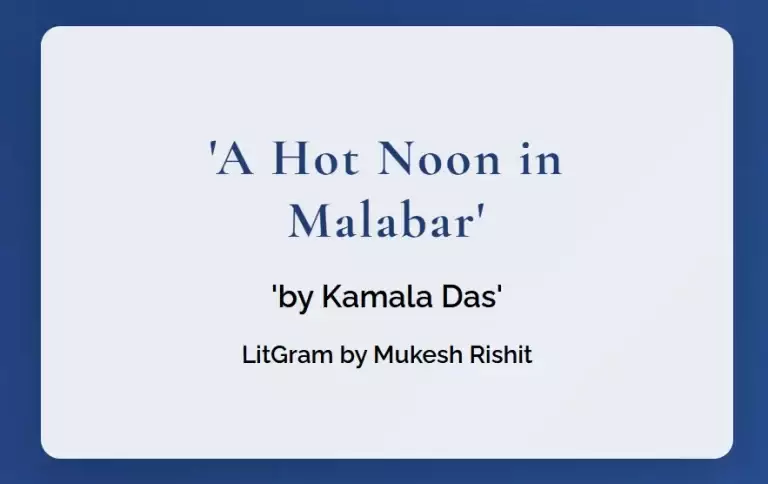“A Hot Noon in Malabar” by Kamala Das is much more than a beautifully penned poem—it’s a journey into nostalgia, culture, and a slice of Indian life unique to its time. The poem, included in her anthology Summer in Calcutta (1965), ties together her longing for childhood, her connection to her Malabar roots, and her readers’ collective desire to understand the strength of memory. By peeling back the layers of this poignant work, we unearth themes of home, displacement, and identity that resonate universally.
Introduction to “A Hot Noon in Malabar”
What does it mean to long for a time and place lost to us? Kamala Das answers this question with disarming simplicity in her poem “A Hot Noon in Malabar.” A childhood steeped in memories of her grandmother’s house and the vibrant life surrounding it serves as the foundation of this hauntingly nostalgic piece. The poem is not just a window into Malabar but an ode to emotions and experiences felt universally by anyone distanced from their origins.
About Kamala Das
Kamala Das, an iconic figure in Indian English literature, was born on March 31, 1934. With a body of work that spans poetry, memoirs, novels, and short stories, she redefined the boundaries of expression for women in a patriarchal society. Her work, often autobiographical, delves deep into themes of identity, love, home, and displacement. “A Hot Noon in Malabar” reflects her unique blend of confessional poetry and evocative imagery.
The Malabar Shoots Through the Poem
Malabar, a region in Kerala, is woven into the poem not just as a setting but as a character. Its bustling streets, bangle sellers trudging through miles of dust, and the noon heat are palpable. This is the place where her roots intertwine with dirt roads and strangers’ calls—bringing forth an earthy, raw realism.
Themes in “A Hot Noon in Malabar”
- Nostalgia: The yearning for home and the past—the poet’s childhood in Malabar—is the heart of this poem.
- Displacement: Set against her life in Calcutta, the poem carries an undertone of homesickness.
- Ordinary Lives: The fortunetellers, beggars, and bangle sellers symbolize life’s struggles and the human spirit’s resilience.
[INSERT_ELEMENTOR id=”4137″]
Summary
This is a noon for beggars with whining
Voices, a noon for men who come from hills
With parrots in a cage and fortune-cards,
All stained with time, for brown Kurava girls
With old eyes, who read palm in light singsong
Voices, for bangle-sellers who spread
On the cool black floor those red and green and blue
Bangles, all covered with the dust of roads,
Miles, grow cracks on the heels, so that when they
Clambered up our porch, the noise was grating,
Strange.This is a noon for strangers who part
The window-drapes and peer in, their hot eyes
Brimming with the sun, not seeing a thing in
Shadowy rooms and turn away and look
So yearningly at the brick-ledged well. This
Is a noon for strangers with mistrust in
Their eyes, dark, silent ones who rarely speak
At all, so that when they speak, their voices
Run wild, like jungle-voices. Yes, this is
A noon for wild men, wild thoughts, wild love.To be here, far away, is torture.
Wild feet stirring up the dust, this hot noon, at my
Home in Malabar, and I so far away ……..
Through vivid imagery, Kamala Das paints a portrait of a sultry afternoon in her ancestral home. Beggars cry out for alms, fortune-tellers clutch stained cards, and strangers peek through curtains. Every individual is laden with stories, their weather-beaten feet and cracked heels a testament to their enduring struggles. The poem juxtaposes their rustic existence with her current, more alienated reality—a life removed from this vibrancy.
Critical Analysis
Kamala Das infuses realism into her nostalgia, as every visual and sound she describes strikes the reader with authenticity. Symbols such as the parrots used by fortunetellers or the bangles scattered on the house porch’s cool tiles are permeated with meaning. While the rhythm may lack lyrical quality, the poem’s conversational free-form structure amplifies its honesty. The phrase “To be here…is torture” is a piercingly vulnerable admission of emotional pain.
Imagery: A Standout Feature
Das’s images skip the grandiose for the granular. Our senses are flooded by the heat of Malabar and the quiet determination of the bangle sellers devouring the miles with their feet. These details transport the reader directly to the Malabar noon, proving that sometimes, even the simplest observations can hold the most weight.
Wild Men, Wild Thoughts, and Wild Love
Throughout the poem, the word “wild” features prominently. It doesn’t merely convey chaos but the unbridled nature of her emotions. This wildness contrasts sharply with the restriction she feels away from Malabar, symbolizing her struggle between duty and desire.
What is the Theme of the Poem?
At its core, “A Hot Noon in Malabar” is a meditation on belonging. It’s an exploration of how physical distance can create emotional yearning. Simultaneously, it reflects the transient and vibrant lives of others—those who cross the poet’s path and leave imprints on her memory.
Conclusion
Kamala Das’s A Hot Noon in Malabar is a masterclass in economy of words. Using just one stanza, she evokes vivid emotions while transporting readers into her Malabar home. The poem’s universal theme resonates in its yearning for simpler times, proving that nostalgia knows no borders.
FAQs
- What are the key themes in “A Hot Noon in Malabar”?
Nostalgia, displacement, and the struggles of everyday life. - Why is the poem considered autobiographical?
The poem recounts Kamala Das’s own childhood experiences and longing for her ancestral home. - What does “wild love” symbolize in the poem?
It represents unrestrained emotion and a freer, more connected past. - Why does Kamala Das mention bangle sellers?
The bangle sellers symbolize rural life, tradition, and the hardship of those reliant on their crafts. - What is the significance of the title?
The title ties the poem to a specific, evocative memory of the heat and life bustle of Malabar.
In a world where we often rush forward, Kamala Das’s A Hot Noon in Malabar invites us to pause and cherish the roots that ground us in our identities. How many of us still feel the call of home? Perhaps her words are the answer to that wistful longing.



1 Comment
Pingback: My Mother at Sixty-Six: Comprehensive Summary and Analysis (For 12th RBSE)